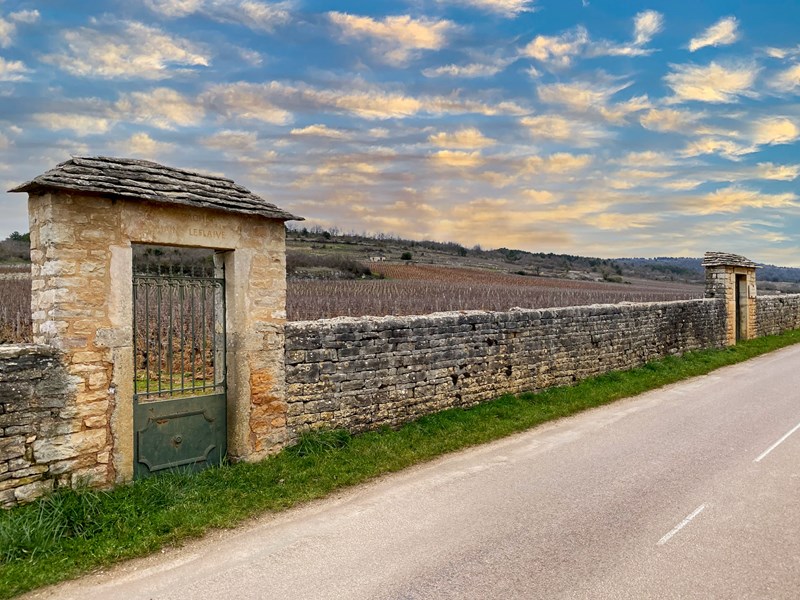Article - RareWine Academy
Domaine Leflaive: Among Burgundy's Greatest Producers
Biodynamics, sustainability and good decisions have secured Domaine Leflaive star status among the world's wine lovers. Here is a portrait of the stunning French domain.
Domaine Leflaive And Biodynamics
When it comes to the very best white Burgundies, the conversation will inevitably turn to Domaine Leflaive. It is a producer that has in many ways shown how white wine has a rightful place at the top of the podium. Indeed, for decades, legendary Anne-Claude Leflaive's hard work and dedication have been more than instrumental in this domain's reputation and legacy.
Anne-Claude Leflaive has shown what happens when you go from conventional to biodynamic production while owning some of the best vineyards in the world. Then the wines go from being excellent to moving up into their own league. Domaine Leflaive and Domaine Leroy have undergone the shift from conventional to biodynamic production in parallel, and together they have shown the world that biodynamics is a good priority when quality is more important than quantity.
Domaine Leflaives From Start To Now
Domaine Leflaive took shape in earnest in the years following the ravages of the phylloxera in Burgundy from 1875 onwards. It was a difficult time for the locals, where vineyards lay deserted, and no one wanted to cultivate them. In the early 20th century, Joseph Leflaive bought 25 hectares in and around Puligny-Montrachet. Following this acquisition, Joseph Leflaive set about replanting and selecting the perfect rootstocks for each terroir, creating the breeding ground for the first top wines of Domaine Leflaive.
In 1953, Joseph Leflaive passed away, but fortunately he had taught his two sons his trade so that they could successfully continue what he had started. Vincent and Jo Leflaive took over good and healthy vineyards and with their attention to detail in the cellar they made the family name even more solid. Indeed, even at that time, the wines of the Leflaive family were considered benchmarks for the other producers in the area.

Ensuring The Family Business
In 1973, the family decided to change the ownership of the company so that it would not be split up over the generations. From today's perspective, it was a more than sensible decision, allowing Domaine Leflaive to remain in family ownership. Many famous family estates are being broken up into atoms these years due to French inheritance laws, so the financial basis is only becoming more complicated.
In 1986, Joseph's son Olivier Leflaive was appointed co-manager of the domain along with his uncle Vincent. This collaboration continued until Vincent's daughter Anne-Claude Leflaive joined the management team in 1990, together with Olivier.
Biodynamics Introduced By Madame Anne-Claude Leflaive
Anne-Claude Leflaive was the next generation who really came to play a major role in the Domaine Leflaive we know today.
Anne-Claude became manager with her uncle Olivier Leflaive in 1990, and from the start she helped to elevate the estate's wines to a new level. From 1993, Anne-Claude managed the domain herself and converted all the vineyards to biodynamic farming. The wines that have come from the domain during this period have helped to convince other producers to go down this path to elevate production from good wines to sublime ones.
Anne-Claude, along with Madame Lalou Bize-Leroy, were known as the two progressive and uncompromising women who, with a shared vision, had a major impact on the introduction of biodynamics in Burgundy. Today, most of the top producers in Burgundy follow this way of thinking to a greater or lesser extent.
Leflaive Modernised In The Family's Biodynamic Spirit
Sadly, Anne-Claude passed away at the age of just 59 in 2015 after a bout with cancer. Since then, Joseph Leflaive's great grandson Brice de La Morandiere has been the driving force. Brice continues in the same style as Anne-Claude, and even in difficult vintages, the biodynamic calendar and uncompromising approach is maintained.
Brice de la Mondarie is joined in the cellar by Mr Pierre Vincent. Pierre Vincent joined Domaine Leflaive in 2005 from a similar position at Domaine de la Vougeraie. He is a specialist in working with biodynamic wines and that is why Anne-Claude Leflaive hired him in the first place.
Brice Pierre has Vincent with him in both field and cellar. Vincent also worked closely with Anne-Claude Leflaive. Today they have built a wine cellar based on Anne-Claude's ideas. It is shaped like an egg so that the energy in the cellar, according to Anne-Claude, flows optimally.
Biodynamics believes in the different energies of the soil and how they affect the must during the process. In an egg-shaped container, what happens is that the wine never sits still, but is in constant motion. The movement is a result of the rotation of the earth and the shape of the container.
Brice de la Morandiere is also making his own strong mark on the family domain. Both winery and cellar have been modernised in the family spirit. Sustainability and minimal environmental footprint are Leflaive's vision, and it is followed in every conceivable process of winemaking.
Following a period of problems with premature oxidation of several wines, Brice has also implemented a new cork as well as new vinification methods to reduce premature oxidation of the wines. In addition, he has been in charge of expanding the land holdings in both Puligny-Montrachet as well as further south in Burgundy with Macon as the focal point.

It All Starts In The Vineyard
Domaine Leflaive today has some of the best vineyards in Burgundy for the production of white wine. Their Grand Cru appellation vineyards deserve a brief review here.
The Montrachet vineyard is the holy grail of white wine – the best placed vineyard in Burgundy to grow Chardonnay, and therefore the best vineyard in the world for white wine. It is surrounded by Grand Cru vineyards, which also produce wines of a very high standard. Though rarely at the same high level as Montrachet itself.
Domaine Leflaive is privileged to own plots on four out of these five Grand Cru vineyards. On all the parcels, Leflaive is considered one of the best producers, but there are other great wines coming from here.
Montrachet, Grand Cru
The entire Montrachet vineyard measures eight hectares, which are divided equally between the communes of Chassagne and Puligny, both of which have the surname Montrachet. There is no qualitative difference between the two parts of the estate, and the vineyard is shared between 16 different owners, each making their own cuvée from the estate. In addition, grapes are regularly sold to the major negociants, so there can be up to 20 different wines on the market in a large vintage.
On the Chassagne-Montrachet side, Leflaive owns 0.081 hectares of vines planted in 1960. Leflaive is one of the most talented players on the Montrachet site, in close competition with Ramonet, Lafon and Domaine de la Romanée-Conti.
Chevalier-Montrachet, Grand Cru
Chevalier-Montrachet measures almost 7.5 hectares and is considered the best of the other vineyards here. Here, Leflaive has 1.83 hectares spread over three parcels, which are grouped together in the upper, middle part of the field. The vines were planted between 1955 and 1980.
Here, Leflaive is the second largest landowner - second only to Bouchard Père & Fils. In addition to top wines from Leflaive, Domaine d'Auvenay, Ramonet and Louis Latour also supply fabulous wines from Chevalier-Montrachet.
Bâtard-Montrachet, Grand Cru
Bâtard-Montrachet measures almost 12 hectares and is thus the largest of these Grand Cru vineyards. Like Montrachet, it is divided between Puligny and Chassagne. There is of course more variation in quality here due to the size of the field – but the best wines are of the very highest level.
One of the best wines from this vineyard comes from Leflaive, which practices its wine magic on 1.91 hectares spread over four parcels, with two in Chassagne and two in Puligny-Montrachet. The vines were planted between 1962 and 1989.
Also at the highest level are Domaine de la Romanée-Conti, Pierre-Yves Colin-Morey and Domaine d'Auvenay, which plays along at Bâtard-Montrachet.
Bienvenues-Bâtard-Montrachet, Grand Cru
Leflaive is the largest holder at Bienvenues-Bâtard-Montrachet. The vines, planted in 1958, are located on Leflaive's 1.15 hectares situated on the northern part of the appellation. The land is part of Bâtard-Montrachet, although the wines produced here are slightly different.
From Grand To Premier Cru - And New Wines In The Pipeline
In addition to these four fine Grand Cru appellation vineyards, Domaine Leflaive owns plots on five Premier Cru vineyards in Puligny-Montrachet, with Les Pucelles being the most famous. They also own a few village-appellation parcels and one parcel within Puligny that is not classified. The latter produces their excellent Bourgogne blanc.
To meet a greater demand as well as a growing market for the best white wines from Burgundy, Domaine Leflaive has expanded its business in recent years. They now also work on vineyards in Auxey-Duresses as well as Macon and Pouilly-Fuissé.
Strong And Promising Future For Domaine Leflaive
The future of Domaine Leflaive looks strong in many ways. The wines are looking fantastic and getting high scores from the world's best wine critics. The new and cheaper land holdings will probably mean that Domaine Leflaive can reach a wider audience. And when more people are exposed to a given brand, they will naturally want to taste the producer's very best. Demand will rise - and so will the price. With improved winemaking and a continued biodynamic approach, quality is assured for many years to come.
As the above paints a picture, Domaine Leflaive is in good hands – also in the future. What Anne-Claude Leflaive has built has created an even higher level than before. In the middle of Puligny-Montrachet a memorial stone has been raised in the honor of Anne-Claude Leflaive. A memorial stone shaped like an egg (of course) following biodynamic ideas. From here she can look out over her favourite vineyard Bâtard-Montrachet with Montrachet behind her. In many ways, she has helped shape both the past and the future of Burgundy.
Brice de la Morandiere has captured the soul and continues to work with just the right team around her. The vineyards the family has access to are of the highest quality and with a curiosity to find new vineyards, expansion is happening in a healthy and good way. Quality is maintained and the wines that come with Domaine Leflaive on the label keep up.
